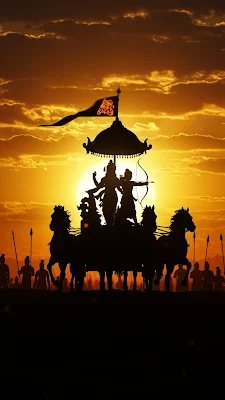Here's an article about Bhagavad Gita Chapter 1, Verse 18, with context, meaning, and insights.
Understanding Bhagavad Gita Chapter 1, Verse 18
Sanskrit Verse:
धृष्टकेतुश्चेकितानः काशिराजश्च वीर्यवान् |
पुरुजित्कुन्तिभोजश्च शैब्यश्च नरपुङ्गवः ॥ १८ ॥
Transliteration:
dhṛiṣṭaketush chekitānaḥ kāśirājaś cha vīryavān |
purujit kuntibhojaś cha śaibyaś cha narapuṅgavaḥ ||
English Translation:
“Drishtaketu, Chekitana, the valiant king of Kashi, Purujit, Kuntibhoja, and Shaibya—the best among men—all these heroes also blow their respective conch shells.”
'धृष्टकेतु, काशी के पराक्रमी राजा चेकितान, पुरुजित, कुन्तिभोज और पुरुषों में श्रेष्ठ शैब्य - ये सभी वीर भी अपने-अपने शंख बजाते हैं।'
Context of the Verse:
This verse is part of Bhagavad Gita’s first chapter, "Arjuna Vishada Yoga" (The Yoga of Arjuna's Dejection). In these initial verses, Sanjaya is describing the battle preparations to King Dhritarashtra. He narrates the scene on the battlefield of Kurukshetra, focusing on the warriors from both sides.
In Verse 18, Sanjaya lists more prominent warriors from the Pandava side who are ready for battle, each blowing their conch shells. This act symbolizes their readiness, courage, and determination.
Who Are These Warriors?
- Dhritaketu: The ruler of the Chedi kingdom. He is known for his bravery and loyalty to the Pandavas.
- Chekitana: A powerful Yadava warrior allied with the Pandavas.
- Kashi Raja (King of Kashi): Famed for his valor; he leads his troops with distinction.
- Purujit and Kuntibhoja: Brothers, maternal uncles of the Pandavas (from Kunti's side), known for their heroism.
- Shaibya: A revered and powerful monarch, often mentioned as “narapungava,” meaning the best among men.
Deeper Insight:
This verse highlights the presence of many capable and devoted warriors on the side of the Pandavas. Their participation strengthens the moral and military force of Arjuna and his brothers. The verse also indicates the diverse alliances formed by the Pandavas, symbolizing the righteous cause they represent.
The blowing of the conch shells by these warriors isn't just a ritual. It represents:
- Confidence and moral resolve
- The call for righteousness (Dharma)
- A psychological assertion of readiness against adharma (unrighteousness)
Philosophical Reflection:
Even in the battlefield of life, the presence of allies (whether they are people, virtues, or knowledge) strengthens one's inner resolve. The heroes in this verse remind us of the importance of support, both external and internal, when facing challenges. The "blowing of the conch" can be seen as announcing our preparedness to stand for truth and justice.
Hindi Meaning:
धृष्टकेतु, चेकितान, काशिराज (शक्तिशाली योद्धा), पुरुजित, कुन्तीभोज, तथा शैब्य (श्रेष्ठ पुरुष)—ये सभी महायोद्धा अपने-अपने शंख बजाते हैं। यह संकेत है कि युद्ध आरंभ होने को है और ये योद्धा धर्म की रक्षा के लिए पूरी तरह तैयार हैं।
Conclusion:
Bhagavad Gita 1.18 may seem like a simple description of warriors blowing conch shells, but it subtly conveys the readiness of the Pandava army to uphold righteousness. It is a reminder that preparation, courage, and righteous intention are key to confronting life’s battles.



















.webp)